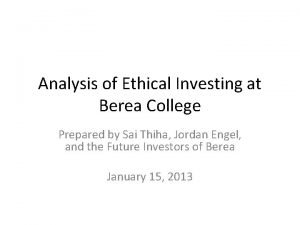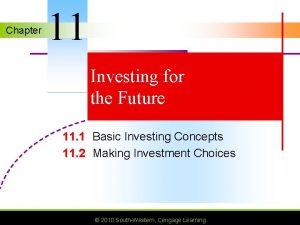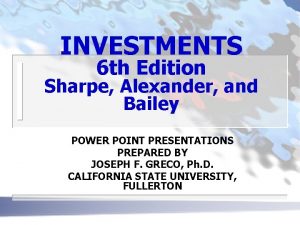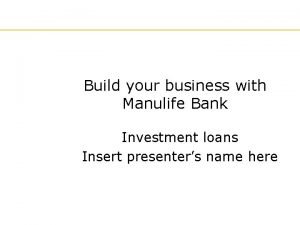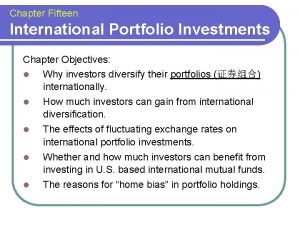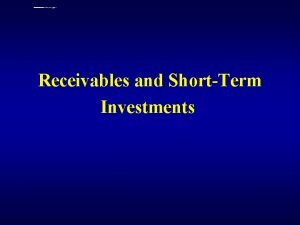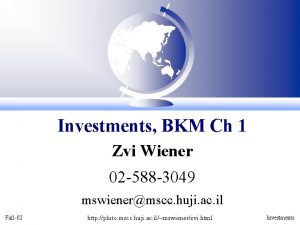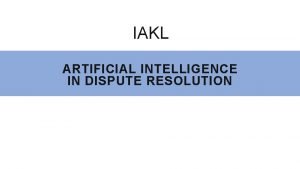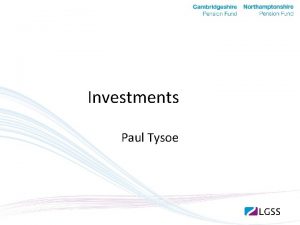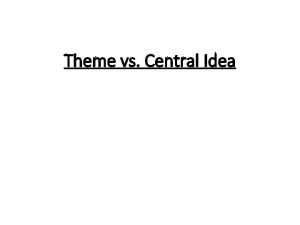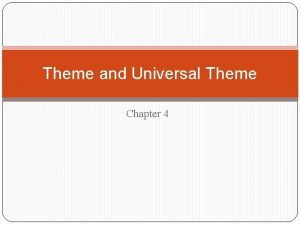Theme 5 Investments Reasons to Consider Investments 1













- Slides: 13

Theme 5: Investments

Reasons to Consider Investments 1) Beat inflation: if the inflation rate is 3%, you want to make investments that equal 3% or higher. 2) Increase wealth 3) Invest in companies and products because you believe in specific products 4) (? ) Fun and challenging

The Role of Risk • Investing risk: the chance that an investment’s value will decrease. • Usually, the greatest risk includes the greatest potential profit. o Risk takers: investors who like to take on a great deal of risk. o Risk adverse: those afraid to make investments in which they might lose some or all. • Diversification: the spreading of risk among many types of investments.

Types of Risk 1) Interest-rate risk: is the risk that inflation will rise faster than the return on your investments. 1) Fixed rate investments are at risk of this issue if they are locked in at low rates. 2) Political risk: refers to actions the government might take that would reduce the value of your investment (regulations). 3) Market risk: caused by the business cycle during periods of decline. 4) Nonmarket risk: Unpredictable trends like terrorism and natural disasters.

Criteria for Choosing an Investment: • • • Degree of safety (risk of loss) Degree of liquidity (ability to get your money quickly) Expected dividends or interest Expected growth in value Reasonable purchase price Tax benefits

Investment Choices: Low Risk/Low Return: • Corporate and Municipal Bonds: debt obligation of a corporation. (Borrowed money with interest) • U. S. Government Savings Bonds: debt obligation of a state. (Borrowed money with interest) Medium Risk/Medium Return: • Stocks: unit of ownership of a company o o • Mutual Funds: the pooling of money from many investors to buy a large selection of securities. o o • • Dividends Capital Gains Debt securities are bonds Equity securities are stocks Annuities: An annuity is a contract between you and an insurance company that requires the insurer to make payments to you, either immediately or in the future. You buy an annuity by making either a single payment or a series of payments. Similarly, your payout may come either as one lumpsum payment or as a series of payments over time. Real Estate

Investment Choices: High Risk/High Return: • Futures: a contract obligates the buyer to purchase (or the seller to sell) stock or a commodity (a product that is mined or grown) for a specified price on a specified date in the future. • Penny Stocks => many losers, few winners

What is a Corporation? • Firm that meets certain legal requirements to be recognized as having a legal existence, as an entity separate and distinct from its owners. Corporations are owned by their stockholders (shareholders) who share in profits and losses generated through the firm's operations, and have three distinct characteristics • (1) Legal existence: a firm can (like a person) buy, sell, own, enter into a contract, and sue other persons and firms, and be sued by them. It can do good and be rewarded, and can commit offence and be punished. • (2) Limited liability: a firm and its owners are limited in their liability to the creditors and other obligors only up to the resources of the firm, unless the owners give personalguaranties. • (3) Continuity of existence: a firm can live beyond the life spans and capacity of its owners, because its ownership can be transferred through a sale or gift of shares.

Corporation Structure

Owning Stock • Stock is an ownership interest of a company • Public Corporation: a company whose stock is traded openly on stock markets. o Dividends: money paid to stockholders from the corporation’s profits o Capital gains: the profit from selling shares at a higher rate than it was purchased. • You can trade in round lots (multiple of 100 shares) and odd lots (fewer than 100). Brokerage firms usually charge more for odd lots. • Preferred Stock: represents a type of stock that pays a fixed dividend but has no voting rights. • Common Stock: represents a type of stock that pays a variable dividend and gives the holder voting rights.

Rating Stocks • Stock Price • The Company- Earning power v. debt • Low Interest Rates = increase stock investment o High rates = lower stock investment • Bull v. Bear Markets • Stock Indexes o Dow Jones, Standard and Poor’s 500 (S&P 500), and NASDAQ o This measure of many stocks can give a means to measure the strength of the whole market.

Securities Market • Securities Market Place: a financial market place where bonds and shares are made available and traded. • NYSE (New York Stock Exchange) o To Be traded on the exchange, a company needs a certain minimum number of public sharers. o 9: 30 AM- 4 PM o Trading floor is where all securities are traded o Floor brokers buy and sell stocks on the exchange o Horseshoe shaped counters, trading posts, with brokers to the floor brokers o Brokerage firms (E-Trade or Morgan-Stanley) phone or send by computer order numbers to the firms booth and given to a floor broker to carry out at the trading post.

Short Sale • Short Sale: involves selling stock borrowed from a broker that must be replaced at a later time. You then sell the borrowed stock, knowing that you must buy it back later and return it to the broker. You are betting that the price will drop so you can buy it back at a lower price and make a profit. • Example: 100 shares of X Stock. You sell it @ $28/share. In two weeks, it lowers to $20/share. How much do you make (without considering any charges)?
 Theme for english b by langston hughes
Theme for english b by langston hughes What is the difference between theme and genre
What is the difference between theme and genre What is the difference between theme and universal theme?
What is the difference between theme and universal theme? Meaning of universal theme
Meaning of universal theme Investments berea
Investments berea Put and take account
Put and take account Rudolf niessler
Rudolf niessler Bus-123: introduction to investments
Bus-123: introduction to investments Manulife investment loan
Manulife investment loan International portfolio investments
International portfolio investments Accounting for short term investments
Accounting for short term investments Investments bkm
Investments bkm Intercorporate investments
Intercorporate investments Phyrrho investments it s an english predictive coding case
Phyrrho investments it s an english predictive coding case




